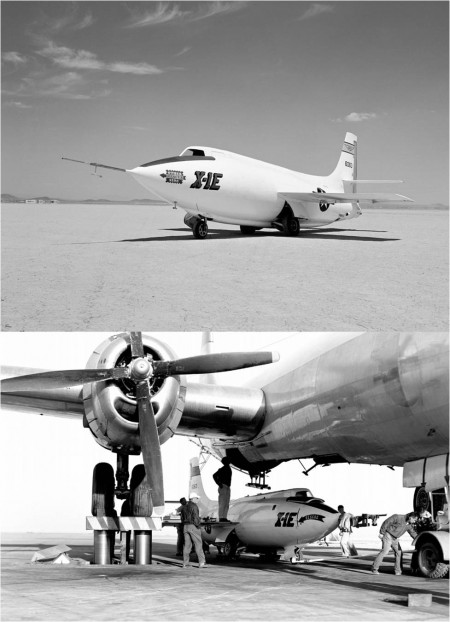Fifty-four years ago this week, the famed Bell X-1E rocket-powered flight research aircraft flew for the twenty-sixth and final time. The flight marked the close of the highly productive twelve-year flight test history of the first series of X-aircraft.
In the years immediately following World War II, the United States began a relentless pursuit of increasing the speed and altitude capability of manned aircraft. Indeed, the effectual motto of that historic period was “Faster, Higher, and Farther”. The primary flight research tool for accomplishing this daunting objective was the now-famous X-aircraft series.
It all began with the USAF/Bell XS-1 rocket-powered flight research aircraft. With Bell Aircraft test pilot Jack Wollams at the controls, the XS-1 made its first glide flight at Pinecastle Army Airfield, Florida in January of 1946. Twenty-one months later (Tuesday, 14 October 1947), Captain Charles E. “Chuck” Yeager broke the sound barrier when he flew the XS-1 (Ship 1, S/N 46-062) to Mach 1.06 (700 mph).
Less than two years after the XS-1 first achieved supersonic flight, the type established performance records for both speed and altitude. Yeager hit Mach 1.45 (957 mph) in the XS-1 on Friday, 26 March 1948. Then, on Monday, 08 August 1949, USAF Major Frank K. “Pete” Everest soared to 71,902 feet at the controls of the same aircraft.
The USAF/Bell X-1A (S/N 48-1384) took aircraft performance to the next level in 1953 and 1954. In a flight in which he almost lost his life, USAF Major Charles E. “Chuck” Yeager flew the airplane to Mach 2.44 (1,620 mph) on Friday, 12 December 1953. This feat was followed by USAF Major Arthur “Kit” Murray when he flew the craft to an unofficial world altitude record of 90,440 feet on Thursday, 26 August 1954.
Meanwhile, the USAF/Bell X-1B (S/N 48-1385) first flew in September of 1954 with USAF Lt Col Jack Ridley doing the piloting honors. The X-1B was flown to Mach 2.3 (1,541 mph) by Pete Everest in December of 1954. NACA test pilot John B. “Jack” McKay hit an altitude of 62,952 feet in January of 1957. Although neither of these marks exceeded the X-1A’s performance records, the X-1B contributed significantly to the flight research database.
Neither the USAF/Bell X-1C nor USAF/Bell X-1D (S/N 48-1386) fulfilled the measure of their creation. In fact, the X-1C was never constructed. The X-1D made its initial glide flight on Tuesday, 24 July 1951 with Bell Aircraft test pilot Jean “Skip” Ziegler in the cockpit. However, the X-1D crashed to destruction on Wednesday, 22 August 1951 when it had to be jettisoned from its EB-50A launch aircraft due to unresolvable fuel system issues.
The USAF/Bell X-1E was actually a rebuild of the No. 3 XS-1 (S/N 46-063). The airplane’s XLR-11 propulsion system was upgraded via installation of a low-pressure turbopump system. Doing so eliminated the heavy and dangerous high-pressure fuel system utilized in previous X-1 aircraft. Other changes included the use of a new thin wing (4 percent thickness ratio) design and a streamlined, upward-opening canopy. The later feature permitted the first-time installation of an ejection seat in an X-1 vehicle.
The X-1E was flown 26 times between December of 1955 and November of 1958. NACA test pilot Joseph A. Walker flew the first 21 of these missions while fellow NACA test pilot John B. “Jack” McKay piloted the final 5 test sorties. Walker flew the maximum speed and altitude missions. He reached an altitude of 73,458 feet on Wednesday, 15 May 1957 and a speed of Mach 2.22 (1,487 mph) on Tuesday, 08 October 1957.
The final X-1E flight took place on Thursday, 06 November 1958 with Jack McKay at the controls. Although nondescript in terms of performance, the flight was historic in that it was the last of 239 flight tests in the pioneering X-1 series. From 1946 to 1958, a total of seven (7) X-1 aircraft and twenty-eight (28) Bell Aircraft, NACA and USAF pilots flew these missions.
The X-1E was retired after its twenty-sixth flight when structural cracks were discovered in its fuel tanks. Interstingly, this airframe flew 100 of the X-1 series flights (74 as the No. 2 XS-1 and 26 as the X-1E). Today, it is on public display in front of Building 4801 at NASA’s Dryden Flight Research Center (DFRC) at Edwards Air Force Base, California.


